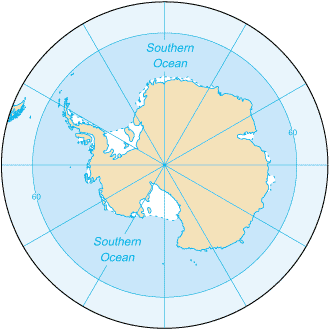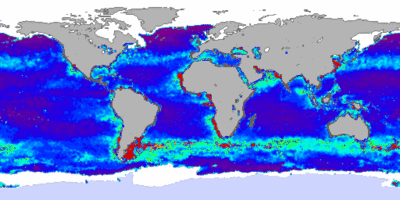Southern Ocean
2007 Schools Wikipedia Selection. Related subjects: Antarctica; General Geography
| Earth's five oceans |
|---|
|
The Southern Ocean, also known as the South Polar Ocean (and formerly the Antarctic Ocean), is the body of water encircling the continent of Antarctica. It is the world's fourth largest ocean and the latest to be defined, having been accepted by a decision of the International Hydrographic Organization (IHO) in 2000, though the term has long been traditional among mariners. This change reflects the recent findings in oceanography of the importance of ocean currents.
Of the 68 member nations, 28 responded to the IHO's survey in 2000, and all responding members except Argentina agreed to define a new ocean. The name Southern Ocean was selected with 18 votes, beating the alternative Antarctic Ocean. Half of the votes were cast for ending the ocean at the imaginary 60 degrees south line of latitude (with no land interruptions at this latitude), with the other 14 votes cast for other definitions as far north as 35 degrees south.
Other sources such as the National Geographic Society continue to show the Atlantic, Pacific and Indian Oceans as extending to Antarctica.
Geography
The Southern Ocean is oceanographically defined as an ocean connected with the Antarctic Circumpolar Current, which circulates around Antarctica. It includes Amundsen Sea, Bellingshausen Sea, part of the Drake Passage, Ross Sea, a small part of the Scotia Sea, and Weddell Sea. The total area is 20,327,000 square kilometers (7,848,000 mi²)
Features
The Southern Ocean is located in the Southern Hemisphere possessing typical depths between 4,000—5,000 meters (13,000 to 16,000 ft) deep over most of its extent with only limited areas of shallow water. The Antarctic continental shelf is generally narrow and unusually deep, its edge lying at depths up to 800 meters (2,600 ft), compared to a global mean of 133 meters (436 ft).
Solstice to solstice in line with the sun's seasonal influence, the Antarctic ice pack fluctuates from an average minimum of 2.6 million square kilometers (1.0 million mi²) in March to about 18.8 million square kilometers (7.2 million mi²) in September, more than a sevenfold increase in area.
The Antarctic Circumpolar Current moves perpetually eastward—chasing and joining itself, and at 21,000 kilometers (13,000 mi) in length— it is the world's longest ocean current, transporting 130 million cubic meters (4.6 billion ft³) of water per second—100 times the flow of all the world's rivers.
Its greatest depth is 7,235 meters (23,737 ft) at the southern end of the South Sandwich Trench, at 60°00'S, 024°W
Climate
Sea temperatures vary from about −2 to 10 °C (28 to 50 °F). Cyclonic storms travel eastward around the continent and frequently are intense because of the temperature contrast between ice and open ocean. The ocean area from about latitude 40 south to the Antarctic Circle has the strongest average winds found anywhere on Earth. In winter the ocean freezes outward to 65 degrees south latitude in the Pacific sector and 55 degrees south latitude in the Atlantic sector, lowering surface temperatures well below 0 degrees Celsius; at some coastal points intense persistent drainage winds from the interior keep the shoreline ice-free throughout the winter.
Natural hazards
Icebergs can be found at any time of year throughout the ocean. Some may have drafts up to several hundred meters; smaller icebergs, iceberg fragments and sea ice (generally 0.5 to 1 meter thick) are also a problem for ships. The deep continental shelf is floored by glacial deposits varying widely over short distances. High winds and large waves during much of the year, along with ship ice, especially May-October make the area even more dangerous. The remoteness of the region makes sources of search and rescue scarce.
Environment
Current issues
Increased solar ultraviolet radiation resulting from the Antarctic ozone hole has reduced marine primary productivity ( phytoplankton) by as much as 15% and is damaging the DNA of some fish. Illegal, unreported, and unregulated fishing, especially the landing of an estimated five to six times more Patagonian toothfish than the regulated fishery, likely affects the sustainability of the stock. There is also a high incidental mortality of seabirds resulting from long-line fishing for toothfish.
International agreements
The Southern Ocean is subject to all international agreements regarding the world's oceans. In addition, it is subject to these agreements specific to the region:
- The International Whaling Commission prohibits commercial whaling south of 40 degrees south (south of 60 degrees south between 50 degrees and 130 degrees west). Japan regularly does not recognize this provision in regards to its whaling permit and whaling for scientific research and occasionally carries out whale hunts in the region.
- The Convention for the Conservation of Antarctic Seals has limited seal hunting.
- The Convention on the Conservation of Antarctic Marine Living Resources regulates fishing in the region.
Many nations prohibit mineral resource exploration and exploitation south of the fluctuating Polar Front, which is in the middle of the Antarctic Circumpolar Current and serves as the dividing line between the very cold polar surface waters to the south and the warmer waters to the north.
Since the Antarctic Treaty covers the portion of the globe south of sixty degrees south, claims to Antarctica and all islands in the Southern Ocean are suspended.
Economy
Fisheries in 1998-99 between 1 July and 30 June landed 119,898 tonnes, of which 85% was krill and 14% Patagonian toothfish. International agreements were adopted in late 1999 to reduce illegal, unreported, and unregulated fishing, which in the 1998-99 season landed five to six times more Patagonian toothfish than the regulated fishery. In the 1998-99 Antarctic summer 10,013 tourists, most of them seaborne, visited the Southern Ocean and Antarctica, compared to 9,604 the previous year. Nearly 16,000 tourists were expected during the 1999-2000 season.
Ports and harbors
Few ports or harbors exist on the southern (Antarctic) coast of the Southern Ocean since ice conditions limit use of most of them to short periods in midsummer; even then some cannot be entered without icebreaker escort. Most Antarctic ports are operated by government research stations and, except in an emergency, are not open to commercial or private vessels; vessels in any port south of 60 degrees south are subject to inspection by Antarctic Treaty observers.
The major ones that are operational include: Esperanza Base, Villa Las Estrellas,Chile, Mawson Station, McMurdo Station, Palmer Station, Scott Base, and offshore anchorages in Antarctica

